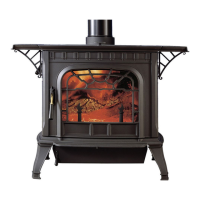_~
H
~
~
_ _ _ _ H
~_
~
_ _
~
Always~eargloveswhen
BUILDING A FIRE
I operatmg the stove.
Never let the ashes build up to over
2"
in
depth.
Excessive ash buildup can prevent proper venting
of
ex-
haust gases. Also do
not
overfill the ashpan. Ash buildup
between the ashpan and the bottom grate can cause the
bottom grate to overheat and
wear out prematurely.
The
Oakwood was designed to provide access to
the ashpan without the need for opening the main door.
Before opening the ash door and removing the ashpan,
open the bypass damper. Wearing heavy protective gloves,
open the ash door and remove the ashpan
by
pulling it
forward
by
the handle. Close the ash door and damper
bypass before taking the ashes outside for safe disposal.
Ashes should be placed in a metal container with a
tight fitting lid. The closed container
of
ashes should
be
placed
on
a noncombustible floor
or
on the ground, well
away from all combustible materials; pending final dis-
posal.
If
the ashes are disposed
of
by
burial
in
soil
or
otherwise locally dispersed, they should
be
retained
in
the
closed container until all cinders have thoroughly cooled.
Never use the ash disposal
cont.ainer for other trash.
Wood ash can
be
added to your garden
or
compost.
Overfirin&:
Avoid overfiring your stove, a potentially hazard-
ous situation which can lead to overheating
of
combus-
tible materials, damage to the stove, and
in
extreme cases,
cause a fire. Overfiring is caused by:
1.
Too
much
air
flowing through the stove too quickly. 2. You may have
positioned the primary air control lever too far to the right.
3. Inadvertently left the damper open or 4.
Not
kept up
with routine maintenance, such as checking door gaskets
for wear.
Overfiring results
in
excessive fuel consumption, and
may
cause parts
of
the stove
or
chimney connector to
glow red.
If
you
notice signs
of
overfiring, reduce the air
supply
to
the fire, and review the Maintenance section in
this manual.
In the event
of
a chimney
fITe,
call your local
fITe
department; make sure everyone is safely out
of
the house.
Reduce the air intake
of
the stove as
much
as possible
using the air control lever; close the bypass damper to
further restrict air flow.
Do
not throw water
on
the
fITe;
this can cause stove damage and create an even more
dangerous situation. Have your chimney professionally
cleaned and inspected before resuming burning in your
stove.
As you begin to operate your stove
at
higher tem-
peratures, you will notice a
"hot" or unpleasant smell; this
is
just
the paint going through the curing process,
and
will
disappear after a few fires.
10
Oakwood Wood Stove
CAUTION
The stove is hot while
in
operation. Keep
children, clothing
and
furniture away. Contact
tmay cause skin burns.
WARNING
Never leave the stove unattended
if
either
the ash
or
load door is open. Overfiring
may result.

